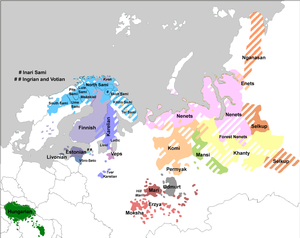lingvo.wikisort.org - Language
American Finnish, Fingliska or Fingelska is a form of the Finnish language spoken in North America.[1][2][3] It has been heavily influenced by the English language. American Finnish was used actively until the 1950s and after that it has been declining, and Finnish Americans have been switching to English. Even some basic phrases like tätsrait 'that's right' were borrowed from English.[4] The form of speech was studied by Pertti Virtaranta in 1960, and the first American Finnish dictionary was made in 1992.[5] It has influence from English both in syntax and vocabulary.[1] In 2013 Finnish was spoken by 26,000 people in their homes.[6] In the town of Oulu, Wisconsin, there are documented third-generation speakers of American Finnish,[7] and in Stanton Township, Michigan, there are children who speak the language.[8] American Finnish also retained loanwords from Swedish, which Modern Finnish lost.[9]
| American Finnish | |
|---|---|
| Native to | United States, Canada |
Native speakers | 26,000 (in their homes) United States (2013) 15,295 Canada (2016) |
Language family | |
| Language codes | |
| ISO 639-3 | – |
| IETF | fi-021 |
 Location of Finnish people in America, however only a few can speak American Finnish. | |
Those in the second and third generations who speak American Finnish are usually bilingual and tend to use English most often. There have been some negative attitudes to "impurities" in American Finnish, however American Finns usually consider it a language of their own and dislike linguistic purism.[9]
Finnish Americans sometimes have problems understanding modern Finnish of Finland. There is not much areal variation in American Finnish; however, first, second and third generation speakers have more variation in their speech, especially as the amount of English influence differs in generations.[5]
Features
There are also grammatical differences from Finnish, such as consonant gradation. In American Finnish the letter k remains unchanged, unlike in Finnish: laki 'law', lakit 'laws' (Finnish: laki, lait). And in American Finnish the first person plural ending has often been dropped: me ei saa 'we can't' (Finnish: me emme saa). Another difference in American Finnish is that the sound /i/ doesn't change into an /e/ when conjugated: kieli 'language', kielit 'languages' (Finnish: kieli, kielet). [10]
Vocabulary
American Finnish has many loanwords from English, but also retained older Swedish loanwords that Finnish lost.
| English | Fingelska | Modern Finnish |
|---|---|---|
| bed | peti | vuode |
| blanket | plänketti | huopa |
| kitchen | kyökki/kitsi | keittiö |
| onion | lööki | sipuli |
| telephone | telefooni | puhelin |
| telegram | telekrammi | sähke |
| hay barn | heinä baana | heinälato |
| hospital | hospitaali | sairaala |
| county | kaunti | maakunta |
| farm | farmi | maatalo |
| room | ruuma | huone |
| potato | potaatti | peruna |
| towel | hantuuki | pyyhe |
Grammar
Cases
| Case | Fingelska |
|---|---|
| nominative | ruuma |
| genitive | ruuman |
| accusative | ruuman |
| essive | ruumana |
| partitive | ruumaa |
| translative | ruumaksi |
| inessive | ruumassa |
| elative | ruumasta |
| illative | ruumaan |
| adessive | ruumalla |
| ablative | ruumalta |
| allative | ruumalle |
| comitative | ruumineen |
| instructive | ruumin |
In American Finnish the possessive suffixes are rarely used..[9]
Examples of American Finnish
On heitä enemmän, mutta he ovat nyt muusia hunttaamassa.
"There are more of them, but they are moose hunting."
fiksata
"to fix"
'Nyt pitää äkkiä koolata Albertille
"Now I have to call to Albert fast."[1]
See also
- Finnish Americans
- Finnish Canadians
- Oulu, Wisconsin
- Finglish
References
- "Mihin fingelskaa tarvitaan?". Kotimaisten kielten keskus.
- "Fingelska". www.suomisanakirja.fi.
- "Amerikansuomi". www.suomisanakirja.fi.
- Pitkänen, Silja & Sutinen, Ville, Juhani (2014). Amerikansuomalaisten tarina.
{{cite book}}: CS1 maint: multiple names: authors list (link) - "Amerikansuomalaisten kieli". yle.fi.
- Bureau, US Census. "Detailed Languages Spoken at Home and Ability to Speak English". The United States Census Bureau. Retrieved 2021-03-29.
- "Täällä saunotaan ja puhutaan suomea kolmannessa polvessa – IS vieraili Amerikan Oulussa". Ilta-Sanomat. May 28, 2017.
- "Reportaasi | Yhdysvalloissa on paikkakunta, jossa joka toisella on suomalaiset juuret – "Pikku-Suomessa" luotetaan Trumpiin ja saunomiseen, mutta tietokoneet herättävät yhä epäilyksiä". Helsingin Sanomat. December 2, 2017.
- "The Finnish Language in the United States". www.genealogia.fi. Archived from the original on 2017-02-22. Retrieved 2021-03-30.
- Martin 1993, s. 97–101.
External links
- American-Finnish recordings (in Finnish)
- Amerikansuomalaisten kieli (about Fingelska, in Finnish)
- American Finnish examples at Wikisource
- American Finnish incubator plus
Другой контент может иметь иную лицензию. Перед использованием материалов сайта WikiSort.org внимательно изучите правила лицензирования конкретных элементов наполнения сайта.
WikiSort.org - проект по пересортировке и дополнению контента Википедии
